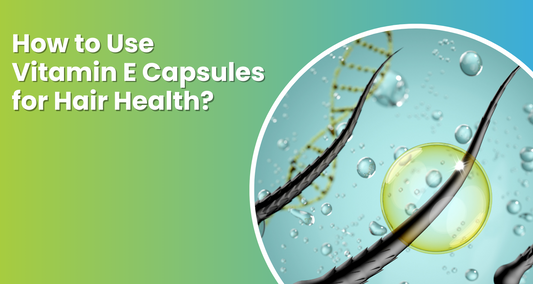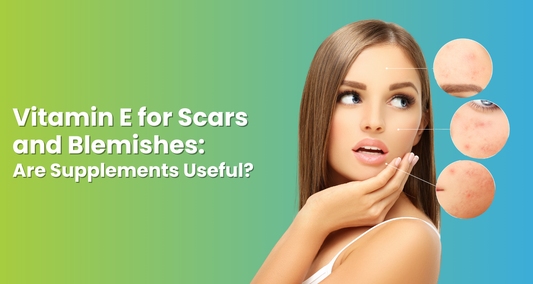Navigating the complex world of nutrients and their impact on our health can be daunting, but understanding Vitamin E deficiency symptoms is vital to overall wellness. Though often overshadowed by its more famous counterparts, Vitamin E is a silent protector, protecting cells from oxidative damage while supporting essential bodily functions.
In this guide, we'll investigate the essential role that Vitamin E plays, identify signs of its deficiency, and highlight why taking notice of these symptoms is paramount to improving health.
What Is Vitamin E?
Vitamin E is among the fat-soluble nutrients found in various food and supplement forms. It serves primarily as an antioxidant, protecting cells against damage caused because of the harmful molecules known as free radicals that are linked with heart disease, cancer, and other ailments.
Furthermore, Vitamin E is integral to immune function, DNA repair, and other metabolic processes.
Causes of Vitamin E Deficiency
Vitamin E deficiency is typically caused by conditions that interfere with fat absorption since Vitamin E is a fat-soluble nutrient. These conditions may be genetic or result from digestive system diseases.
One common genetic cause is Ataxia with Vitamin E Deficiency (AVED), in which the body cannot transport enough Vitamin E effectively for use by neurological tissues.
This leads to significant neurological symptoms if left untreated with high doses of Vitamin E supplementation.
Digestive Disorders
Diseases like Crohn's, cystic fibrosis, and chronic pancreatitis can significantly interfere with a body's ability to effectively absorb fats - and, ultimately, sources of Vitamin E from food.
When this happens, even when someone consumes enough vitamin E from their diet alone, their body cannot use it efficiently; this often requires medical management and supplements to maintain normal vitamin E levels.
Liver and Gallbladder Diseases
The liver plays an essential role in storing and regulating Vitamin E levels within the body. Cirrhosis or blocked bile ducts may impede this function, resulting in Vitamin E deficiency in the system.
Bile production by the gallbladder is also essential to fat absorption; vitamin E absorption may be significantly compromised if its flow becomes compromised due to cholestasis or gallbladder removal.
Premature Infants
Premature infants are at greater risk for vitamin E deficiency due to their immature digestive systems and high demand in early life for this vital nutrient. Vitamin E supplementation may be required to avoid potential complications related to Vitamin E deficiency.
Understanding these causes is integral for accurately diagnosing and treating Vitamin E deficiency. If you suspect yourself at risk, consulting a healthcare provider would be your best course of action.
Also, they can offer guidance in managing any underlying conditions as well as how best to Vitamin E supplements safely if required.
Symptoms of Vitamin E Deficiency
Though rare, vitamin E deficiency manifests through various symptoms that reveal its importance for bodily well-being. It commonly affects the muscular and nervous systems, but its influence may also extend into vision, immune function, and blood health.
Muscle Weakness and Coordination Issues
One of the primary Vitamin E deficiency symptoms is muscle weakness. Individuals might find performing tasks requiring muscle strength challenging while experiencing general fatigue. Coordination problems also arise, making activities that require fine motor skills difficult.
This symptom stems from Vitamin E's role in protecting muscle cells against oxidative damage; without enough of it, cell membranes become vulnerable, leading to degeneration of muscles, which results in weakness.
Neurological Issues
Vitamin E is pivotal in relieving oxidative stress on the nervous system. A deficiency can lead to peripheral neuropathy - manifesting as tingling sensations or numbness in extremities like hands and feet - or, in more serious cases, ataxia, an illness marked by a lack of muscle coordination that impairs various bodily movements.
Immune System Deterioration
Vitamin E plays an essential role in supporting an effective immune system, and low levels reduce its ability to ward off pathogens effectively. This leaves individuals more susceptible to infections and slow healing processes as a result of infections or diseases compromising immunity.
This symptom is especially worrying in individuals suffering from preexisting medical conditions that already compromise immunity.
Vision Deterioration
Studies have shown that eyes are particularly vulnerable to oxidative damage, which vitamin E helps protect against.[1] A deficiency could result in retinopathy - an eye disease in which the retina degrades, leading to impaired vision - making early diagnosis and intervention essential.
Anemia
Vitamin E is vital in protecting red blood cell health. Without it, red blood cells may disintegrate prematurely, resulting in hemolytic anemia - leading to symptoms like fatigue, shortness of breath, and dizziness.
Vitamin E protects fatty acids in red blood cell membranes from oxidation, which, if left uncovered, can become fragile and break easily, creating hemolytic anemia symptoms such as fatigue.
Reproductive Issues
Although less prevalent, severe Vitamin E deficiency has been linked with reproductive issues. Antioxidant properties found within Vitamin E may play an essential role in maintaining reproductive health, so any lack of antioxidants might compromise fertility and overall reproductive function.
Diagnosing Vitamin E Deficiency
Recognizing and diagnosing Vitamin E deficiency requires a thorough assessment of symptoms and medical testing. Healthcare professionals usually begin their investigation by reviewing a patient's clinical history and diet to detect risk factors or symptoms that point toward deficiency, such as muscle weakness, coordination issues, immune system decline, vision problems, or anemia.
Clinical Evaluation
Doctors will perform a clinical evaluation to detect signs associated with low vitamin E levels. They'll consider factors like overall health, diet habits, and any medical conditions that might hinder fat absorption - all of which may contribute to Vitamin E deficiency. A thorough discussion regarding their diet could reveal gaps and contribute valuable insight.
Laboratory Testing
Laboratory testing is the definitive means of diagnosing Vitamin E deficiency. Healthcare providers use blood tests for alpha-tocopherol to accurately assess vitamin E levels in blood samples taken from their patients and interpret these results alongside any clinical findings to make an accurate diagnosis.
Sources of Vitamin E
Vitamin E is usually present in many food sources, making it accessible through a healthy diet. Almonds and sunflower seeds make delicious snacks while being excellent sources of Vitamin E - helping boost intake easily!
Plant-based oils like sunflower, wheat germ, and safflower oil contain significant quantities of this essential nutrient; used as cooking or salad oils, they contribute significantly towards meeting daily dietary needs.
Plant-Based Oils
One of the wealthiest sources of Vitamin E can be found in plant-based oils. Sunflower and safflower oils, often used in culinary settings, provide an easy way to incorporate them into your daily routine. In contrast, wheat germ oil provides another potency source that can be added to salad dressings or smoothies for an easy way to incorporate Vitamin E.
Nuts and Seeds
Nuts such as almonds are not only heart-healthy, they're packed full of Vitamin E. Sunflower seeds also offer plenty of this important antioxidant with each serving!
Green Leafy Vegetables
Spinach and broccoli are among the leafy greens that have long been recognized for their many health benefits, including excellent sources of Vitamin E. Incorporating these into meals provides essential vitamins and meets daily vitamin requirements.
Fortified Foods
Many cereals and juices contain added vitamin supplements, such as Vitamin E. This provides an additional source of essential nutrition, particularly for those who might otherwise not consume enough from natural food sources alone.
Conclusion
At its core, recognizing and treating Vitamin E deficiency are both vital in maintaining overall health. By understanding its symptoms and eating foods rich in Vitamin E-rich foods, like broccoli or almonds, early detection and treatment are key in safeguarding overall wellness.
Consult healthcare professionals if you suspect a deficiency and take proactive steps toward leading a healthier and more vibrant life - your body will thank you!
Disclaimer: These statements have not been assessed by the FDA. The information contained within this page is for educational purposes only. It is not intended to replace the advice or attention of health care professionals.
References




